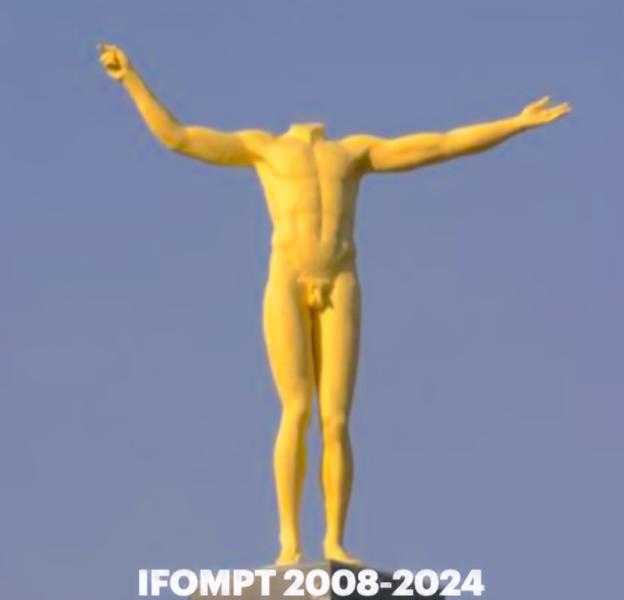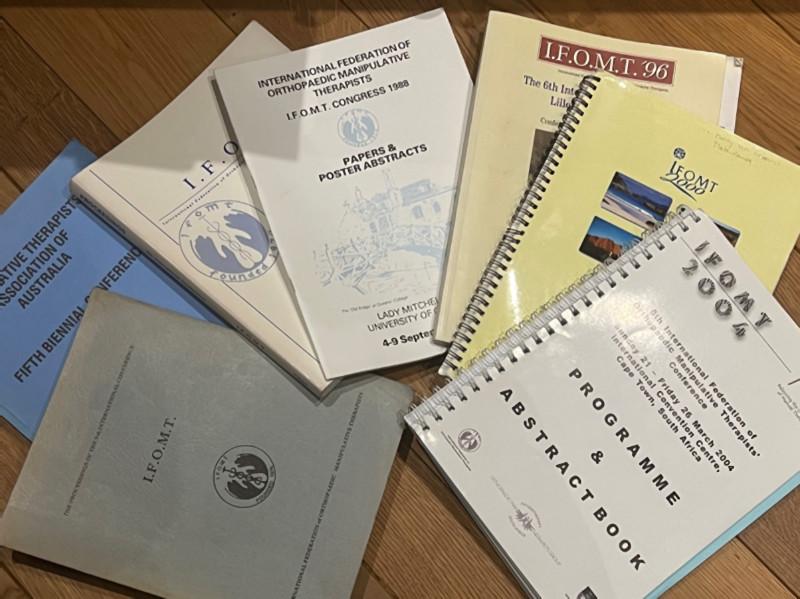
In this Case for Orofacial (musculoskeletal Therapy)
As (musculoskeletal) physical therapist professionals from around the globe gather in Basel for the International Federation of Orthopedic Manipulative Physical Therapists (IFOMPT) Conference 2024, there is an air of anticipation about the latest advancements in musculoskeletal therapy. Yet, there remains a critical area often overlooked since the Rotterdam 2008 conference: the cranio-orofacial region.
Despite mounting evidence supporting musculoskeletal therapy's effectiveness in treating persistent orofacial dysfunction and pain, it seems this significant area continues to receive insufficient attention in the field of the leaders in musculoskeletal Therapy; the IFOMPT . This persistent oversight calls for a closer examination, especially given the rising number of studies advocating for the integration of orofacial considerations into general musculoskeletal practice.
Orofacial pain, encompassing discomfort in the face and mouth area, as well as related structures like the neck and shoulders, can profoundly affect an individual's quality of life. (Oghli et al 2020). It often manifests as headaches, jaw pain, and even disturbances in neck functions like mobility, (muscular)stability. The causes vary from dental issues to nociceptive, nociplastic situations to lack of motor control like parafunctional activity ( e.g bruxism ) postural imbalances advocated by different psycho-emotional risk factors which making it a complex field for assessment and treatment. From internal and external evidence, the integration of musculoskeletal orofacial therapy into treatment plans has shown promising results, offering relief where traditional methods sometimes fall short.
The evidence is clear: several systematic reviews published last year highlighted significant improvements in patients with chronic jaw and facial pain following targeted musculoskeletal interventions (van der Meer et al 2017, von Piekartz et al 2023).These treatments, which include manual therapy, exercise, and patient education, provide a holistic approach that addresses both the symptoms and underlying causes of orofacial pain which has a good or excellent outcome.
What may be the reason?
However, despite this growing body of evidence, sessions dedicated to orofacial musculoskeletal therapy were notably sparse at recent IFOMPT conferences as you may read in table 1. This gap is not just a missed opportunity; it is a disservice to the countless patients who could benefit from these therapeutic approaches. The question then arises: why is the orofacial area not getting the attention it rightfully deserves within the musculoskeletal IFOMPT community? Some reasons are discussed below.

| IFOMPT Conference,year and place | IFOMPT Conference Titel | Oral presentations without head or face pain | Oral presentations with headache/orofacial |
| 2008 Rotterdam (NL) | Connecting science with quality of life | 71 | 3 |
| 2012 Québec(CA) | A Rendez-Vous of Hands and Minds | 68 | 6 |
| 2016 Glasgow ( UK) | The year of IFOMPT | 66 | 2 |
| 2024 Basel (CH) | Crossing Bridges | 50 | 2 |
Table 1 Number of (non-)orofacial presentations at the last 4 IFOMPT conferences
(i)One possible reason could be the traditional segmentation of medical specialties. Often, orofacial pain is seen as the domain of dentists and maxillofacial specialists, thus creating a barrier to interdisciplinary collaboration. Furthermore, there is a need for more specialized training and education among physical therapists to handle these complex cases effectively.
(ii) Another reason may be a lack of training in the IFOMPT curriculum in this area..Schaffer et al.'s survey(2018) on IFOMPT education concerning TMD and upper cervical assessment and treatment reveals inconsistencies in duration and content in how post-professional OMPT programs address TMD education. Most programs, however, consistently offer more training in cervical spine disorders than in TMD. These results point to the need for further research to evaluate whether TMD education in these programs is still insufficient.
Based on my personal experience, musculoskeletal therapists, including those who teach in the IFOMPT domain, often face challenges with average topics such as:
- Understanding the innervation of the temporomandibular joint (TMJ).
- The functions and interactions between the trigeminal and facial nerves.
- The dual compartments of the TMJ and their specific functions.
- How dental occlusion affects TMJ and neck function.
- Distinguishing between myogenous TMD and bruxism.
- Identifying types of perception changes during craniofacial-orofacial headaches.
It is reasonable to expect that an IFOMPT specialized musculoskeletal therapist, even if not intensively involved in clinical work with patients suffering from orofacial dysfunction and pain, would possess this fundamental knowledge.
(iii)Another reason may be the paradigm shift in rehabilitation where, since 2018-2019, IFOMPT has mandated the integration of "communication" more prominently into training programs. As a result, Pain Science and Pain Neuroscience Education received higher priority in the curriculum.
(iv)Another factor could be the paradigm shift towards “research” playing a significant role. It is concerning that many PhD students in Physiotherapy who do not have an IFOMPT diploma, and thus have not experienced the IFOMPT curriculum and therefore have not the clinical experience, are conducting research in musculoskeletal therapy to complete their PhDs. While more research in musculoskeletal therapy is certainly beneficial, research questions are not always posed from a clinical perspective. In my opinion, clinical questions, particularly those concerning facial-TMD issues, are significantly underrepresented. This shortfall occurs because PhD students often lack training in this area, unless their supervisors have specialized expertise that can assist them. However, it is worth noting that there are few musculoskeletal physical therapists with both an IFOMPT diploma and a PhD who are engaged in research.
The medical world recognizes orofacial dysfunction and pain, but it does not recognize cervical headaches.
Apologies, but what manual therapists might not want to hear is still the reality: the medical community still does not recognize 'cervical' headache as a distinct entity. Despite the significant efforts of experts like Gwenn Jull, Toby Hall, and Dean Watson during the 1990s and early 2000s, who began to substantiate their clinical experiences with foundational research published in well-regarded journals, there has been little change in this area.
Additionally, it is apparent that most IFOMPT musculoskeletal therapists are not familiar with the diagnostic criteria for TMD as outlined by the International Consortium for Myofascial Pain Diagnostics (accessible at InForm TMD Assessment] (https://ubwp.buffalo.edu/rdc-tmdinternational/tmd-assessmentdiagnosis/dc-tmd/) and the International Classification of Orofacial Pain (ICOP 2020).(https://journals.sagepub.com/doi/10.1177/0333102419893823). These frameworks offer significant insights for assessment, management, and research in musculoskeletal therapy and provide excellent integration with other evidence-based disciplines such as dentistry, orofacial surgery, neurology, and psychology.
Driven by this knowledge the Craniofacial Therapy Academy (CRAFTA) organized the hybrid conference successfully held on June 7 and 8 2024 , titled "TMD AND OROFACIAL PAIN PHYSICAL THERAPY MEETS DENTISTRY," (www.crafta.org)). The conference concluded that there are clear overlaps between dentistry and musculoskeletal therapy. Functionally-minded dentists have shown a readiness to cooperate and reach consensus, but they observe a lack of specialized craniofacial therapy with robust skills grounded in evidence-based practice. Consequently, they are welcoming physiotherapists with open arms to the American Academy of Orofacial Pain (AAOP) conferences in the US and the Deutsche Gesellschaft für Funktionsdiagnostik (DGFDT) conferences in Germany, both as participants and speakers. Interestingly, while 80% of the attendees were physical therapists, less than 15% were registered with an IFOMPT Diploma.
Crossing Bridges
Can we blame the IFOMPT Teaching organizations, like IMTA? Maybe partwise because the IMTA must deal also with the IFOMPT curriculum which prescribed the objectives and competences for an international curriculum. When IFOMPT lose the head than also the curricula of the international musculoskeletal education organizations may lose it. This is reflected also on the upcoming conference in Basel . Title is “Crossing Bridges”. Crossing Bridges sounds like connecting, challenging new, different ideas, areas, which sounds positive to move forward. This does not apply to the face and head. All proposed Symposiums on face pain are all rejected by the scientific IFOMPT commission. From the nearly 60 keynote lectures and short research presentation only two session of 90 minutes on craniocervical and neck ,orofacial headache themes. Thus, we can conclude that the IFOMPT musculoskeletal therapist is a specialist in musculoskeletal therapy but has limited expertise regarding the face. So, who will manage in the future:
- Neck pain patients whose source of pain is not in the neck
- Face pain following facial trauma and concussions
- Complex cases of vertigo and tinnitus not originating from the vestibular organ
- Young patients experiencing face and head pain after orthodontic treatments
- Symptoms related to facial neuropathies, etc.
Probably not the standard IFOMPT musculoskeletal therapist. They would be the first choice, but perhaps we must accept that this is not the case.
The face our vital instrument for communication, using many muscles to show emotions, from smiles to frowns. It facilitates beauty and it's also key for sensing the world—our eyes see beauty and chaos, our noses detect scents, and our lips and tongue taste and speak. The specialized physical therapist get credits of the medical word to be a part of it but at alas not really supported by the IFOMPT.

Harry von Piekartz
PhD, MSc, BSc.PT, MT (OMPT)
References
- Oghli, I., List, T., Su, N. and Häggman‐Henrikson, B., 2020. The impact of oro‐facial pain conditions on oral health‐related quality of life: A systematic review. Journal of oral rehabilitation, 47(8), pp.1052-1064.
- van der Meer, H.A., Calixtre, L.B., Engelbert, R.H., Visscher, C.M., Nijhuis–van der Sanden, M.W. and Speksnijder, C.M., 2020. Effects of physical therapy for temporomandibular disorders on headache pain intensity: A systematic review. Musculoskeletal Science and Practice, 50, p.102277.
- von Piekartz, H., van der Meer, H. and Olivo, S.A., 2023. Craniofacial disorders and headaches. A narrative review. Musculoskeletal Science and Practice, p.102815.
- Shaffer, S.M., Stuhr, S.H., Sizer, P.S., Courtney, C.A. and Brismée, J.M., 2018. The status of temporomandibular and cervical spine education in post-professional physical therapy training programs recognized by Member Organizations of IFOMPT: an investigation of didactic and clinical education. Journal of Manual & Manipulative Therapy, 26(2), pp.102-108
